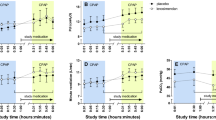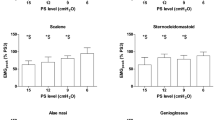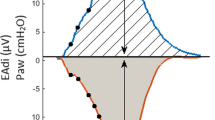Abstract
We investigated 8 patients undergoing continuous ambulatory peritoneal dialysis (CAPD) for diaphragmatic strength and the neuromechanical efficiency of the diaphragm while the abdomen was filled with dialysate and while it was empty. Maximum transdiaphragmatic pressure (Pdimax) served as parameter for diaphragmatic strength; diaphragmatic efficiency was assessed by simultaneously monitoring transdiaphragmatic pressure (Pdi) and diaphragmatic electromyogram (EMGdi) during room-air breathing and hyperoxic CO2-rebreathing. After instilling dialysate, Pdimax increased from 76.7 ± 12.1 cmH2O to 92.2 ± 16.3 cmH2O (P < 0.05). While the slopes of the regression lines relating minute ventilation (VE) to arterial CO2 tension, and the change in VE for a given change in Pdi during hypercapnic rebreathing were similar in both states, the slope of EMGdi vs Pdi was significantly steeper when the abdomen was filled (P < 0.05). The increase in Pdimax observed in the filled state may suggest an adaptive rightward shift in the diaphragm's force-length relationship in CAPD patients, although this mechanism is insufficient to prevent a reduction of neuromechanical efficiency of the diaphragm.
Similar content being viewed by others
References
Banzett RB, Inbar GF, Brown R, Goldman M, Rossier A, Mead J (1981) Diaphragm electrical activity during negative lower torso pressure in quadriplegic man. J Appl Physiol 51:654–659
Bark H, Heimer D, Chaimovitz C, Mostoslovski M (1988) Effect of chronic renal failure on respiratory muscle strength. Respiration 54:153–161
Baydur A (1991) Respiratory muscle strength and control of ventilation in patients with neuromuscular disease. Chest 99:330–338
Braun NMT, Arora NS, Rochester DF (1982) Force-length relationship of the normal human diaphragm. J Appl Physiol: Respirat Environ Exercise Physiol 53:405–412
Bush A, Miller J, Peacock AJ, Sopwith T, Gabriel R, Denison D (1985) Some observations on the role of the abdomen in breathing in patients on peritoneal dialysis. Clin Sci 68:401–406
Cheeseman M, Revelette WR (1990) Phrenic afferent contribution to reflexes elicited by changes in diaphragm length. J Appl Physiol 69:640–647
Druz WS, Sharp JT (1981) Activity of respiratory muscles in upright and recumbent humans. J Appl Physiol: Respirat Environ Exercise Physiol 51:1552–1561
Field SK, Bell SG, Cenaiko DF, Whitelaw WA (1991) Relationship between inspiratory effort and breathlessness in pregnancy. J Appl Physiol 71:1897–1902
Forche G (1986) Austrian reference values for spirometry. Wien Klin Wschr 99:136s
Gandevia SC, McKenzie DK (1986) Human diaphragmatic EMG: changes with lung volume and posture during supramaximal phrenic stimulation. J Appl Physiol 60:1420–1428
Ginzburg AS, Lopata M, Önal E (1989) Effects of loading and unloading the respiratory system on respiratory control and muscle function. Respiration 55:16–27
Gomez-Fernandez P, Sanchez Agudo L, Calatrava JM, Escuin F, Selgas R, Martinez ME, Montero A, Sanchez-Sicilia L (1984) Respiratory muscle weakness in uremic patients continuous ambulatory peritoneal dialysis. Nephron 36:219–223
Green M, Mead J, Sears TA (1978) Muscle activity during chest wall restriction and positive pressure breathing in man. Respir Physiol 35:283–300
Heinzmann HG, Kassabian J, Naqui MN, Lavietes MH (1981) Respiratory load compensation in uremia. Respiration 41:8–16
Jones NL (1988) Calculation of results. In: Jones NL (ed) Clinical Exercise Testing. Saunders, Philadelphia, pp 289–300
Lahrmann H,Wanke T, Zwick H (1990) A digital method of ECG-artefact minimization in inspiratory muscle SEMG. Eur Respir J 3:1875
Lopata M, Evanich MJ, Lourenco RV (1977) Quantification of diaphragmatic EMG response to CO2-rebreathing in humans. J Appl Physiol: Respirat Environ Exercise Physiol 43:262–270
Lopata M, Zubillaga G, Evanich MJ, Lourenco RV (1978) Diaphragmatic EMG response to isocapnic hypoxia and hyperoxic hypercapnia in humans. J Lab Clin Med 91:698–708
Miller JM, Moxham J, Green M (1985) The maximal sniff in the assessment of diaphragm function in man. Clin Sci 69:91–96
O'Brien MJ, van Eykern LA, Prechtl HFR (1983) Monitoring respiratory activity in infants—a non-intrusive diaphragm EMG technique. In: Rolfe P (ed) Non-invasive Measurements, vol 2. Academic Press Inc, London, pp 132–177
Öberg T, Sandsjö L, Kadefors R (1992) Arm movement and EMG mean power frequency in the trapezius muscle: a comparison between surface and intramuscular recording techniques. Electromyogr Clin Neurophysiol 32:87–96
Önal E, Lopata M, Evanich MJ (1979) Effects of electrode position on esophageal diaphragmatic EMG in humans. J Appl Physiol: Respirat Environ Exercise Physiol 47:1234–1238
Önal E, Lopata M, Ginzburg AS, O'Connor TD (1981) Diaphragmatic EMG and transdiaphragmatic pressure measurements with a single catheter. Am Rev Respir Dis 124:563–565
Petrofsky JS (1979) Frequency and amplitude analysis of the EMG during exercise on the bicycle ergometer. Eur J Appl Physiol 41:1–15
Prezant DJ, Aldrich TK, Karpel JP, Lynn RI (1990) Adaptations in the diaphragm's in vivo force-length relationship in patients on continuous ambulatory peritoneal dialysis. Am Rev Respir Dis 141:1342–1349
Read DJC (1966) A clinical method for assessing the ventilatory response to carbon dioxide. Australas Ann Med 16:20–32
Reid MB, Banzett RB, Feldman HA, Mead J (1985) Reflex compensation of spontaneous breathing when immersion changes diaphragm length. J Appl Physiol 58:1136–1142
Road JS, Newman S, Derenne JP, Grassino A (1986) In vivo length-force relationship of canine diaphragm. J Appl Physiol 60:63–70
Sharp JT, Druz WS, Kondragunta VR (1986) Diaphragmatic responses to body position changes in obese patients with obstructive sleep apnea. Am Rev Respir Dis 133:32–37
Siafakas N, Argyrakopoulos T, Andreopoulos K, Filaditaki B, Tzanakis N, Bouros D (1992) Respiratory muscle strength during continuous ambulatory peritoneal dialysis (CAPD). Am Rev Respir Dis 145:A154
Tabary JD, Tabary C, Tardieu C, Tardieu G, Goldspink G (1972) Physiological and structural changes in the cat's soleus muscle due to immobilization at different lengths by plaster casts. J Physiol (Lond) 224:231–244
Wanke T, Schenz G, Zwick H, Popp W, Ritschka L, Flicker M (1990) Dependence of maximal sniff generated mouth and transdiaphragmatic pressures on lung volume. Thorax 45:352–355
Wanke T, Formanek D, Auinger M, Popp W, Zwick H, Irsigler K (1991) Inspiratory muscle performance and pulmonary function changes in insulin dependent diabetes mellitus. Am Rev Respir Dis 143:97–100
Worth H (1988) Electromyography of the respiratory muscles. Prax Klin Pneumol 42:817–819
Author information
Authors and Affiliations
Additional information
Offprint requests to: T. Wanke
Rights and permissions
About this article
Cite this article
Wanke, T., Auinger, M., Lahrmann, H. et al. Diaphragmatic function in patients on continuous ambulatory peritoneal dialysis. Lung 172, 231–240 (1994). https://doi.org/10.1007/BF00164440
Accepted:
Issue Date:
DOI: https://doi.org/10.1007/BF00164440




